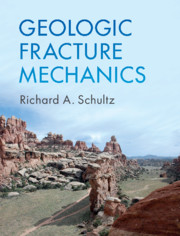Book contents
- Geologic Fracture Mechanics
- Geologic Fracture Mechanics
- Copyright page
- Dedication
- Contents
- Preface
- Acknowledgements
- 1 Introduction to Geologic Structural Discontinuities
- 2 Elastic Rock Rheology and Stress Concentration
- 3 Stress, Mohr Circles, and Deformation at Peak Strength
- 4 Cracks and Anticracks
- 5 Discontinuity Patterns and Their Interpretation
- 6 Faults
- 7 Deformation Bands
- 8 Fracture Mechanics: A Tour of Basic Principles
- 9 Beyond Linear Elastic Fracture Mechanics
- Glossary
- References
- Index
- Answers to Selected Exercises
- References
References
Published online by Cambridge University Press: 03 August 2019
- Geologic Fracture Mechanics
- Geologic Fracture Mechanics
- Copyright page
- Dedication
- Contents
- Preface
- Acknowledgements
- 1 Introduction to Geologic Structural Discontinuities
- 2 Elastic Rock Rheology and Stress Concentration
- 3 Stress, Mohr Circles, and Deformation at Peak Strength
- 4 Cracks and Anticracks
- 5 Discontinuity Patterns and Their Interpretation
- 6 Faults
- 7 Deformation Bands
- 8 Fracture Mechanics: A Tour of Basic Principles
- 9 Beyond Linear Elastic Fracture Mechanics
- Glossary
- References
- Index
- Answers to Selected Exercises
- References
- Type
- Chapter
- Information
- Geologic Fracture Mechanics , pp. 529 - 586Publisher: Cambridge University PressPrint publication year: 2019



